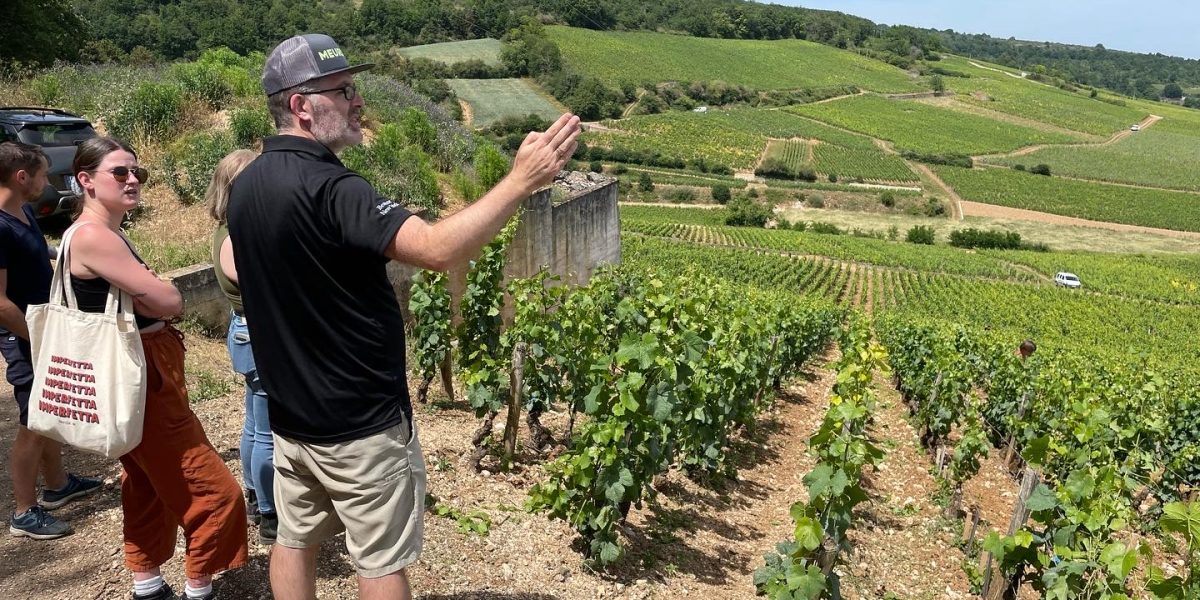
By Myles Trapp, Assistant Wine Director at Auberge du Soleil, Rutherford, CA
From June 12th to June 17th of this year, I joined two other sommeliers on a wine tour of Burgundy sponsored by SommFoundation and Bertrand Leulliette of importer Bertrand’s Wines. In between our excursions to vineyards and wine cellars, we kept returning to the same topic of conversation: Burgundy is facing a crisis of access and availability. Can we justifiably continue to sell Burgundy to our clients as a value proposition?
If you’re like me, you’ve probably watched in horror as the prices of Grand Cru and Premier Cru Burgundy have skyrocketed in recent years. Coveted blue-chip wines like Domaine de la Romanée-Conti, Coche-Dury, and Raveneau seem to have yanked up prices for the entire region while themselves entering a realm that only the wealthiest members of society can enter. Even basic Bourgogne Régionale for less than $20 retail is a distant happy memory. This presents a dilemma for the on-premise wine trade: We’ve arrived at a situation where village-level Burgundy wines are out of the question as by-the-glass options for many restaurants.
But just as despair darkens the doorstep, enter Leulliette, our host and guide. The importer has quietly been assembling a diverse array of vignerons from appellations across Burgundy for his portfolio; his overarching philosophy is to track down good values and hidden potentials. Many of the producers we visited are valorizing underrated appellations like Fixin, Maranges, and Rully, where they are driven to make exceptional wines that translate the terroir. Many of them found creative paths forward in the industry, often buying fruit or leasing vineyards through métayage or fermage contracts (in some cases as a stopgap until more vineyards come into their possession). Still others are growers who are taking production back into their own hands after generations of selling to co-ops or négociants.
Would you like to pay four times less for Gevrey-Chambertin Premier Cru? Let me introduce you to Domaine Joliet Père et Fils in Fixin. Having sold much of his fruit in the past, Bénigne Joliet is reclaiming the entire crop from his historic Clos de la Pèrriere (established in 1142!). This majestic vineyard is only a stone’s throw from some of Gevrey-Chambertin’s finest crus—in fact, it was ranked in line with Clos Saint-Jacques by Jules Lavalle in 1855—and yet it remains overlooked. The wines it yields are finessed and fine-boned; the 2019 vintage has a gorgeous, silky mouthfeel and sports aromas of crushed berries and sweet herbs.
In Rully, I found the wines of Domaine de la Folie to be vibrant, elegant, and imbued with incredible balance. Its Saint- Jacques Premier Cru is not only fabulous for the price, it could stand shoulder to shoulder with a Meursault or Chassagne- Montrachet. In it, the flavors of crisp apple and mandarin meld seamlessly with notes of beurre noisette and an intriguing, flinty minerality. Perhaps the latter is so salient because the vineyard is planted on only 10 centimeters of topsoil. The vines’ roots descend quite literally straight into the bedrock!
As for that elusive village-level Burgundy at a fair by-the-glass price, consider Domaine la Croix Montjoie, located in the appellation of Vézelay, which sits between Chablis and the Côte d’Or. Vézelay Chardonnay is bright, citrusy, and more generous than that of Chablis, due in part to larger proportions of clay in the soil. With it, this young domaine is crafting lovely wines that are eminently affordable—these are wines of immediate pleasure and gratification. The ace in the hole for Croix Montjoie is its magical ratafia, a fortified vin de liqueur made from grape pomace. If you ever come across this, snap it up, because it will blow your mind. It’s like tasting liquified peach cobbler with Chantilly cream.
So rather than obsess over iconic labels and famous names (while watching your bank account shrink), remember that there are treasures to be found in every corner of Burgundy. You may need to dig a little deeper and take some chances, but it’s worth it. The endless variety of vineyard expressions and winemaking styles is the great joy that Burgundy offers. I thank SommFoundation and Leulliette for leading my colleagues and me down the garden path to enlightenment. Our next step is to share our new discoveries with our guests,friends, and family—and of course, dear reader, with you!